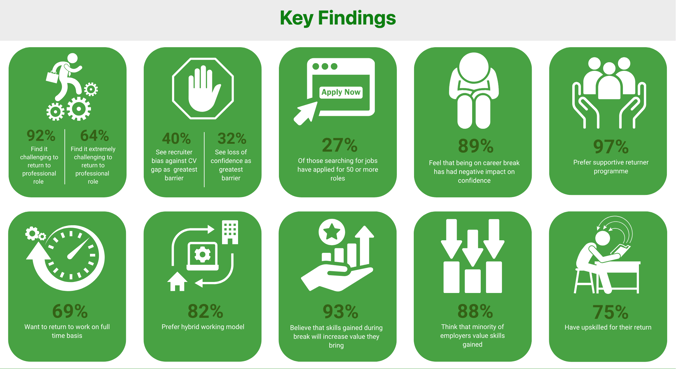Formal tech returner programmes give companies access to already skilled and experienced professionals who might otherwise be hesitant to apply for a position due to their time out of the workforce.
Employer recommendations

➖Read The Government Equalities Office's Employer guidance: helping people return to work which details how an organisation can set up a formal returners programme to recruit talent. It applies to organisations in all sectors and of all sizes.
➖This video outlines top tips for defining the business case for introducing a returners programme (tips by Julianne Miles, CEO & Co-Founder Women Returners and The Diversity Project).
➖Research how returner programmes are/will be perceived in the organisation: understand any barriers or prevailing myths that may need challenging. Senior buy-in is critical to programme success. Senior leaders and people managers must understand the business case so that they can champion the programme internally and externally.
➖A returnship programme must be viewed as a talent attraction strategy, not as a corporate social responsibility scheme. Organisations are not 'lowering the bar' and also want to avoid patronising candidates. Communicate the rationale widely; embedding in internal communications, organisation-wide induction programmes etc.
➖Be clear on the talent being targeted. Recognise that returners are not all ‘returning mums’ and not all women. People interested in a returnship opportunity could have taken a career break for a multitude of reasons including eldercare, health or relocation reasons.
➖Build-in qualitative and quantitative measures to evaluate the success of the programme.
➖Consider how the organisation can embed returners into the wider talent management strategy. Returner programmes shouldn’t be treated as a ‘bolt-on’ initiative but should be part of a consistent and embedded approach to driving D&I. “A returnship programme won’t work if a business’s wider policies around recruitment and selection or job design, for example, aren’t geared towards diversity,” says Dr Jo Ingold, Associate Professor of Human Resource Management and Public Policy at Leeds University Business School. “It’s about having the right mindset and it has to be supported with the right organisational infrastructure and policies'.
➖Ensure great people manager support is available - this is critical to ease returners back into work and provide structure, feedback and support them to make connections. Select people managers who do not need to be convinced of the value of supporting returners, who aren't just going along with a centrally funded ‘scheme’ for a few months without truly committing to them. People managers must understand and support the unique needs of returners, particularly how important flexibility is.
➖Collect and highlight returner success stories from within the organisation or source externally. Incorporate success stories into manager training/briefing and embed in the internal communications strategy.
➖Adapt your recruitment practices to attract returner candidates to all vacancies.
Best practice includes:
- Enhancing and promoting flexible working policies, including advertising jobs as flexible – research shows that many non-workers want to work flexibly, and job adverts offering flexible working attracted more applicants than adverts where flexibility was not mentioned.
- Avoiding unnecessary requirements that might discourage returners, such as asking for recent work experience or references – research shows that presenting roles in terms of years of experience increased callback rates, compared to using chronological dates
- Advertising your job vacancy as suitable for returners with part time options if possible – research shows how advertising jobs as part-time had a positive effect on the number of women that apply.
